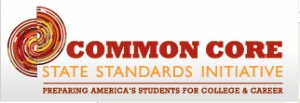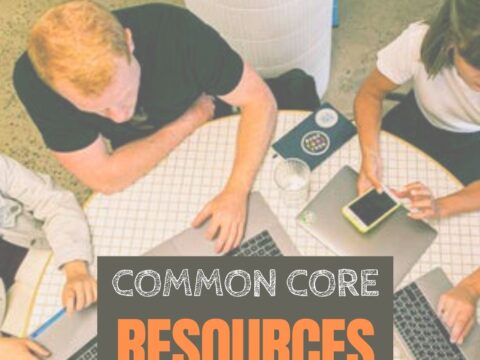
Common Core State Standards, proposed by the National Board of Governors and adopted by 46 states to date, provide a consistent, clear understanding of what students are expected to learn in the critical areas of math, science, language, reading, writing, so teachers and parents know what they need to do to help them. The standards are designed to be robust and relevant to the real world, reflecting the knowledge and skills that our young people need for success in college and careers. With American students fully prepared for the future, our communities will be best positioned to compete successfully in the global economy.
They don’t specifically mention technology as a separate subject, but assume technology will support the teaching of math, science, reading, language, and writing. Last week, I discussed CCSS in general. This week–here are a few of the specific elements that technology can address and examples of projects (not in any particular grade-level order):
Anchor Standards
College and Career Readiness Anchor Standards for Writing–Production and Distribution of Writing–6. Use technology, including the Internet, to produce and publish writing and to interact and collaborate with others.
Language
4d Use glossaries or beginning dictionaries, both print and digital, to determine or clarify the precise meaning of key words and phrases.
4e Use glossaries and beginning dictionaries, both print and digital, to determine or clarify the meaning of words and phrases.
Mathematics
- 1–Compose two-dimensional shapes (rectangles, squares, trapezoids, triangles, half-circles, and quarter-circles)
Example: Students learn how to divide a whole into parts and the names of the parts using KidPix and drawings they create.
- 2. Solve word problems that call for addition of three whole numbers whose sum is less than or equal to 20, e.g., by using objects, drawings, and equations with a symbol for the unknown number to represent the problem.
Example: Students will use art and audio to represent a math problem as a word problem, then ask classmates to solve the word problem using the information provided.
- 5–Use appropriate tools strategically; students can detect possible errors by strategically using estimation and other mathematical knowledge. When making mathematical models, they know that technology can enable them to visualize the results of varying assumptions, explore consequences, and compare predictions with data.
Example: Students explore school to find shapes they’re studying in class
Reading
-
1. Ask and answer questions like who, what, where, when, why, how to demonstrate understanding of key details in a text.
Example: Students write these six essential elements of a story read during the school year into a QR code that is inserted into the cover of the book for other second graders to read before checking out the book
- 2. Determine a theme of a story, drama, or poem from details in the text; summarize the text
Example: Create a class virtual library as students review books read during class and upload the information to a class LibraryThing
- 3. Know and apply grade-level phonics and word analysis skills in decoding words.
Example: Students type several sentences in MS Word. Use the font color palette to label parts of speech, i.e., blue for subject, red for verb. Use sentences from a book they’re reading in class.
-
5. Describe the overall structure of a story, including how the beginning introduces the story and the ending concludes the action.
Example: Use an online comic creator like Lego or ZimmerTwins to write a hero story where each scene is one of the critical parts required to construct a good story.
-
5 for Informational Text Use text features and search tools (e.g., key words, sidebars, hyperlinks) to locate information relevant to a given topic efficiently.
-
6 Informational Text–Distinguish between information provided by pictures or illustrations and information provided by the words in a text.
-
Example: Students explore world symbols (or similar class-related theme) in Google Earth, using both the images, the 3D, the Street View and the embedded text/pictures from world citizens
-
- 7 for Informational Text Interpret information presented visually, orally, or quantitatively (e.g., in charts, graphs, diagrams, time lines, animations, or interactive elements on Web pages) and explain how the information contributes to an understanding of the text in which it appears
- 7 for Literature–Use information gained from the illustrations and words in a print or digital text to demonstrate understanding of its characters, setting, or plot.
Speaking and Listening
- 2 Confirm understanding of a text read aloud or information presented orally or through other media by asking and answering questions about key details and requesting clarification if something is not understood.
Example: Arrange to read native versions of Cinderella (or any other story that differs across nations) via Skype with another kindergarten class across the world. Have students compare and contrast the characters, plot, setting and moral.
- 2 Determine the main ideas and supporting details of a text read aloud or information presented in diverse media and formats, including visually, quantitatively, and orally.
Example: As a summative project, have 4th graders mindmap the characteristics of the different types of writing covered in class during the year.
- 4. Report on a topic or text, tell a story, or recount an experience in an organized manner, using appropriate facts and relevant, descriptive details to support main ideas or themes; speak clearly at an understandable pace
Example: Have students recount an event using text, visual, audio elements to develop the ideas and themes
- 5 Create audio recordings of stories or poems; add drawings or other visual displays to stories or recounts of experiences when appropriate to clarify ideas, thoughts, and feelings.
Example: Create a Voki with a partner to share understanding of a story read during class.
Writing
- 2 Paraphrase portions of a text read aloud or information presented in diverse media and formats, including visually, quantitatively, and orally.
- 2a Introduce a topic clearly and group related information in paragraphs and sections; include formatting (e.g., headings), illustrations, and multimedia when useful to aiding comprehension
- 3. Write narratives to recount a well-elaborated event or sequence of events. Include details to describe actions, thoughts, feelings, temporal words to signal event order and provide a sense of closure.
- 4. Produce clear and coherent writing in which the development and organization are appropriate to task, purpose, and audience
Example: Have students work in groups of five to write a collaborative story that is published on the class blog
- 6 With guidance and support from adults, explore a variety of digital tools to produce and publish writing, including in collaboration with peers.
Example: Students share a story written in class via an online publication tool like Storybird, Photostory or Blabberize.
Example: Students will illustrate and communicate original ideas and stories using the digital tool, Storybird, and share it on the class website or wiki. Storybird is well suited to 1st graders because of the art it offers to inspire creativity.
- 7 Participate in shared research and writing projects (e.g., explore a number of books by a favorite author and express opinions about them).
Example: Students share information collected from books, videos, websites with each other in a brainstorming session, map it in Bubbl.us or iMindMap (if old enough), then write a short summary of what they were most interested in.
Example: Students write a group report by collaborating through Google Docs. They Students will be introduced to all available resources, including the use of online databases to locate and cite relevant information. Students will cite relevant resources
- 7 Conduct short research projects that build knowledge about a topic.
Example: Students write a group report by collaborating through Google Docs. They Students will be introduced to all available resources, including the use of online databases to locate and cite relevant information. Students will cite relevant resources
- 8 Recall relevant information from experiences or gather relevant information from print and digital sources; take notes and categorize information, and provide a list of sources.
Example: Students take a ‘geometry walk’ around school to discover shapes they have discussed in class in their physical world.
Can you fill in any of my blanks?
Jacqui Murray has been teaching K-18 technology for 30 years. She is the editor/author of over a hundred tech ed resources including a K-12 technology curriculum, K-8 keyboard curriculum, K-8 Digital Citizenship curriculum. She is an adjunct professor in tech ed, Master Teacher, webmaster for four blogs, an Amazon Vine Voice, CSTA presentation reviewer, freelance journalist on tech ed topics, contributor to NEA Today, and author of the tech thrillers, To Hunt a Sub and Twenty-four Days. You can find her resources at Structured Learning.




































